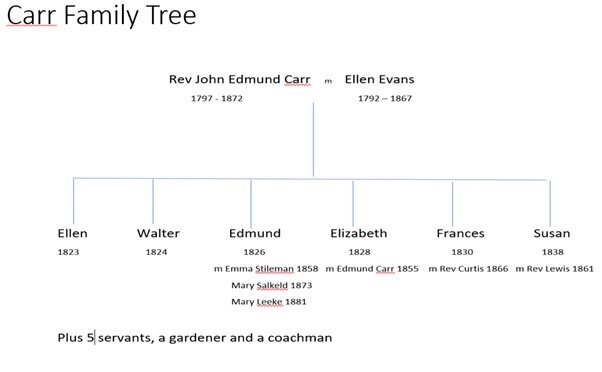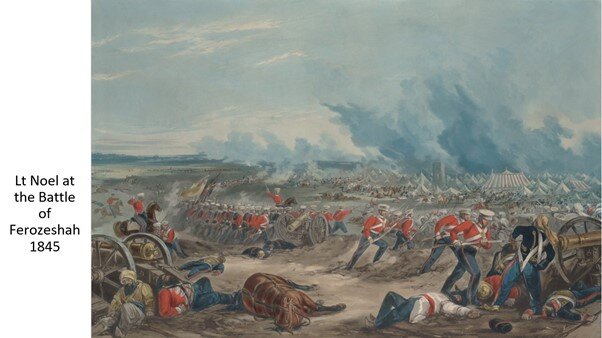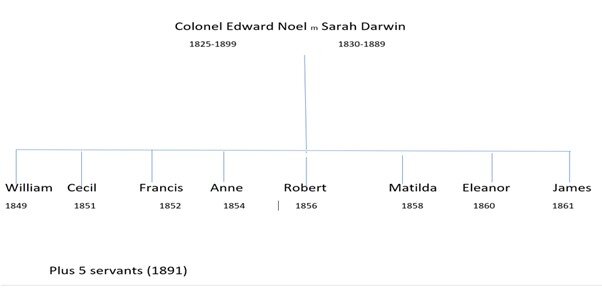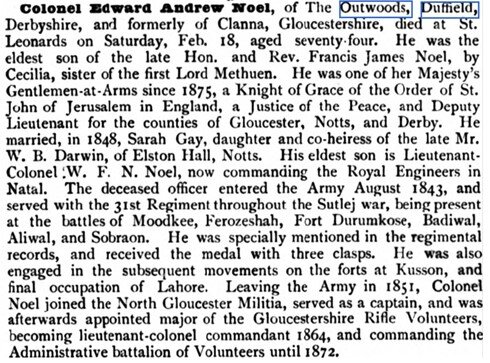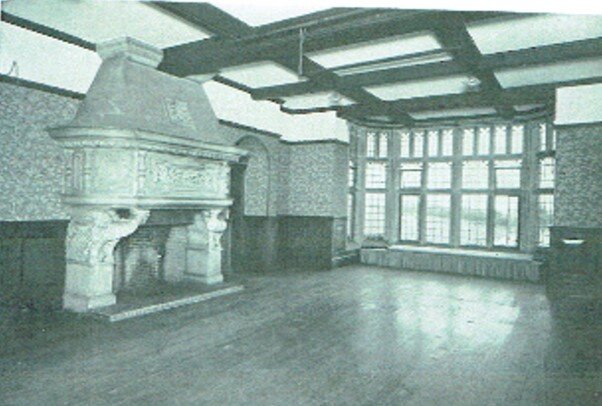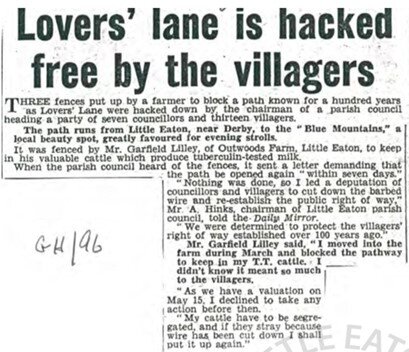
The Outwoods
Introduction
The Outwoods was built in or around 1781 and became one of the most distinctive houses in Little Eaton for over 100 years. Situated to the north of the village, The Outwoods is mentioned in social history books and personal recollections of villagers as a place they visited for special occasions. This article explores the history of The Outwoods land and estate, its owners and residents, and the fate of the original house.
A large part of the Dean of Lincoln’s Estate in Little Eaton was about 90 acres of common land called Outwoods Common. Some of this land was divided into strips worked by villagers. After the Enclosure Act of 1789 this common land was awarded to various people as indicated on an “Award Map”. By 1800, there were three main landowners – the Dean of Lincoln (marked in blue, with the land leased to the Tempest family); the Radford brothers (marked in orange) and William Woollatt (marked in red).
William Woollatt and Dorothy Trowell. 1780-1844
William Woollatt was brought up with his parents who were weavers in Findern. He lived with his sister, Elizabeth, and a lodger, Jedediah Strutt. Jedediah married Elizabeth.
William became a hosier (a stocking maker) and bought the patent to a stocking making machine. He and Jedediah perfected this machine which became the basis for the creation of the Strutt industrial empire, with mills in Belper and Millford. William married Susanna Lalouel whose family were landowners in Little Eaton. William and Susanna had one daughter, Dorothy, who married John Trowell in 1792.
As part of the 1779 Enclosure Act, William Woollatt was awarded the land, about 25 acres in all, some of which had been part of the Estate of John Heiron (died 1767) including “the Broad Closes and the messuage, house (lately erected) and standing upon or near to aforesaid Closes”. (Court Rolls 1781). This is the first reference to the house on Outwoods Common so we can assume it was built in the late 1770s or early 1780s.
William Woollatt as Proprietor of the land paid a total of about £3 in Land Taxes. He had three Occupiers, Joshua Reeve, John Aldred and Elizabeth Longman. Two sisters, Sarah and Mary Ward are recorded as tenants of Edgecroft (now called Edgehill,) a large house and land neighbouring the Outwoods).
William Woollatt’s sole heir was his daughter Dorothy, who had married John Trowell in 1792. She lived with her husband in the house that had been erected earlier, which they later named The Outwoods, after the land on which it was built. Dorothy and John Trowell had a daughter, Elizabeth, who was born at The Outwoods in 1798.
Major John Trowell started to build a much bigger house in Markeaton to be called Trowell House. Unfortunately, he died in 1802 with the house unfinished. Building work stopped for a few years.
William Woollatt gave the estate to his daughter Dorothy in 1802, probably on the death of her husband. William Woollatt then died in 1804 leaving Dorothy the rest of his land and property. This included land and property in Findern, Belper and Little Eaton.
After Mr Woollatt’s death in 1804, Mrs Trowell paid the land tax, and claimed “Herself” as Occupier of High Closes (The Outwoods) and Edgecroft (Edgehill).
Tenants 1806 to 1844.
In 1806, Mrs Trowell and her daughter Elizabeth moved away from The Outwoods, first to Offcote Grove near Ashbourne, then into the impressive villa in Markeaton commissioned by her late husband (architect Richard Leaper) but not finished until some years after Mr Trowell’s death. She re-named that house Thornhill.
Mrs Trowell then let The Outwoods to tenants for many years. It is possible that she had some difficulty letting the property as at least 10-20 adverts appeared in local papers over the next 20 or 30 years. An example is below.
The same advertisement appeared in January 1807. By the 6th and 13th September 1807 Mrs Trowell had authorised Ward and Lockett to advertise the house again.
From 1810 to 1814, Nathaniel Birkinshaw was resident at the Outwoods. He was a Surveyor and timber merchant, but not a very good one as he went bankrupt in 1814 and was required to surrender the house.
Further advertisements appeared in the 1820s and 30s, usually, by this time for Apartments or Lodgings and dealt with by Mrs Trowell’s Bailiff, Thomas Brown – see example below.
She rented out her Little Eaton fields to Thomas Brown. He took over the tenancy of various fields (Ox Close, Little Meadows, the Near Leys, Far Leys and Ley Close), in all about 20 acres. Thomas Brown and his wife Juda (nee Tempest) were by this time living at Park Farm.
Juda was a relation of Mrs Trowell. They and several of their children were in close contact in Little Eaton and at Thornhill for all their lives. Thomas Brown was Mrs Trowell’s Bailiff and dealt with most of the lettings of The Outwoods for her. Park Farm’s address was probably “The Parks Farm, Outwoods. Little Eaton.” or may also have been known as Outwoods Farm.
Dorothy Webster Trowell took in 3 of the Brown’s daughters, Alice, Juda and Lucy, probably in their early teens. Then, by 1830’s, sons, John and William as well. John ran the farm at Thornhill for her and William rose to be Butler, Steward, Bailiff, taking over from his father. They all stayed with her for many years.
Other advertisements appeared in 1832, 1835 and 1837 either for lodgings or apartments at The Outwoods, so it is likely that the large house had by then been converted to a number of smaller residences.
It is also probable that during this time, other buildings were erected that became what is now Home Farm.
By 1842, a Miss Evans, a relative of Dorothy Webster Trowell, was living at The Outwoods.
Miss Evans was a member of the wealthy and important Evans family based at Darley Abbey. She was the Great Aunt of Florence Nightingale.
Another resident was Rev. Richard Mellor Hope and his wife Anne Christina and family. They lived at The Outwoods from 1836 to 1846 before he became Vicar of St. Michael’s in Derby in 1850. They had 6 children (including twins), born between 1839 and 1846. On the children’s Birth Certificates their father’s occupation is given as either Minister in Little Eaton or Incumbent at St Paul’s L.E. They were all baptised at St Paul’s in Little Eaton. The Outwoods may have been known as The Parsonage or Rectory during this time. The Vicarage at the bottom of Vicarage Lane was not built until about 1860.
Mrs Trowell sells up: Rev Carr owns The Outwoods 1844 to 1880
Dorothy Trowell finally sold the house in 1844, and she died in 1852. The house was sold to the Rev. John Edmund Carr for £2,999. His wife Ellen (nee Evans), born 1791, was the daughter of Dorothy Webster Trowell’s cousin, another member of the Evans family of Darley Abbey.
The property was listed as “Tenements, messuages, Buildings, closes, pieces of land ie. 4 Closes called Broad Closes, + Stables, Coachhouse and other outbuildings. 8 acres and Barn Close and rickyard.
The sale also included Acts Croft (which had also been known as Edgecroft or Age Croft and is now Edgehill) and 13 acres.
The Rev. John Edmund Carr had been Vicar of Parwich, (a village 7 miles north of Ashbourne.) The family left, complaining of the cold Parwich climate. They moved to Darley Abbey where the Rev Carr became Perpetual Curate and where their two youngest daughters were born. These two later inherited the Parwich Estate from their 1st cousin Sir William Evans. In 1844 the family moved to The Outwoods.
The Carr’s children were:
1. Ellen (1823-1916) was left behind in Darley Abbey, aged 20, looking after 2 maiden aunts (her Mother’s sisters). When they died she came to live at The Outwoods, aged about 45. After her parents died she was the only one living at The Outwoods, this time looking after 2 maiden Carr Aunts, Anne (1798-1865) and Mary (1802-1879). Both are buried in St Paul’s Churchyard. Ellen stayed in the house until 1879. She never married but was not alone. There were 7 servants living in.
2. Walter (1824 – 1863) went to Trinity College. By the 1861 Census he was calling himself a “Landed Proprietor”. If his land and property were at the Outwoods, he didn’t enjoy it for very long. He died unmarried, aged 38 in 1862, and is buried in Little Eaton. His Mother died in 1867 and is also buried in the family grave.
3. Edmund (1826-1916) left The Outwoods in about 1849 to become Vicar in Wiltshire, Isle of Wight, Westmorland and Carlisle. He came back home from time to time. He officiated at the marriage of his three younger sisters: Elizabeth (in Darley Abbey) in 1855 to Rev. Edmund Donald Carr; Susan in 1861 to a Rev. Lewis; and Frances in St Paul’s in L.E. in 1866.
4. Frances married the Rev George Curtis. In old age she published a booklet entitled “Memories of a long life”. In it she tells a story told to her by her mother of a visit by William Wilberforce (the MP, abolitionist and social reformer) and his wife.
William Wilberforce
Reverend John Carr was a very religious, conscientious man. He worked well with the Rev. Latham (vicar in L.E. and Canon of Lichfield Cathedral.) They worked together removing “priestly decoration” from the Cathedral but fell out over the installation of a window in St Paul’s Church, Little Eaton. The re-opening of St Paul’s Church was reported in the Derby Mercury on 28th April 1869, followed closely by this “protest” from Rev. J.E. Carr:-
Rev Carr continued to object strongly to the window and finally left the church in 1870. He died in 1872.
The Rev Carr’s Will left everything to Edmund. (HIs sister, Ellen, was still living at The Outwoods, still looking after Mary, one of their Carr aunts).
Edmund married Emma in 1858. They had 6 children, the first three born in Isle of Wight, the last three in Carlisle. Emma died at The Outwoods in 1871 (on 29th Dec). She was only 37. She, like many of the Carrs is buried in Little Eaton graveyard. Maybe they were home for Christmas when she died or maybe they were home because Edmund’s father was ill (He died soon after Emma).
Edmund went back to Carlisle after his wife’s and his father’s deaths. He married again in 1873 to Mary Salkeld. Mary was the daughter of a Colonel Salkeld. Edmund began negotiations about this time to sell The Outwoods to Colonel Salkeld (his new wife’s father) and 4 Noel Siblings
In 1874 Court Rolls record that Edmund Carr surrendered The Outwoods to Colonel Salkeld and the Noels.
But Mary too died young, in 1876 aged 32. Col. Salkeld (her father) dropped out of the negotiations. The deal wasn’t finalised until the 1880s.
It is very likely that more building work was carried out at The Outwoods during this time as the house that the Noels eventually moved into was appreciably larger than the earlier house. All the contents of The Outwoods were advertised for sale in the Derby Mercury on 6th and 13th Oct 1880.
5 years later Edmund is on the 1881 Census, as a visitor, a widower, aged 54, staying with the Leeke family at Holbrook Hall. He is also recorded as marrying Mary Leeke, his third wife. Mary was a daughter of the Vicar of Holbrook. Edmund appears to leave his children behind in Carlisle, aged between 11 and 22 by 1881
Edmund became Vicar of Holbrook after his father-in law’s death. He and Mary continued to live in Holbrook, until their deaths in 1904 (Mary) and 1916. Edmund is buried in L.E. churchyard.
With the Outwoods about to be sold in 1880, Ellen retired to Torquay, aged 57. “A gentlewoman, living on independent means” She had 6 servants, two of whom came with her from The Outwoods. She died in 1916 aged 93. Her brother, Edmund does visit her, in 1911 as a widower aged 84, but doesn’t stay.
1880 to 1899: Colonel Edward Andrew Noel.
Colonel Edward Andrew Noel was the grandson of the Earl of Gainsborough. He served with the 31st Regiment of the Indian Army and fought in several battles during the Indian campaign.
Colonel Noel later served in the Gloucestershire Regiment and the Royal Bodyguard. When he retired from the army, he bought The Outwoods from the Carrs, and he and his family lived there until about 1899. The house had clearly been converted back into one large property and was possibly extended, as at this time there were 8 live-in servants.
Colonel Noel married Sarah Darwin, the first cousin once removed of Charles Darwin, who had recently published his revolutionary book The Origin of the Species. Edward and Sarah’s son, William, became a Colonel in charge of British troops in Nepal. Francis became an admiral and Robert and James had distinguished military careers. Their daughter Matilda married the son of a general in 1893 in a grand wedding in Duffield. The Derby Mercury of 20th Sept 1893 reported it thus:-
Colonel Noel was Chairman of the Little Eaton School Board in the 1880s, with John Hastie from Park Farm as his Vice Chairman. Thomas Tatum of Elms farm (now owned by the Strutts) was a Board member as was George Tomlinson Thums, great grandfather of John Easter). The Head teacher was Walter Grocock, great grandfather of Caroline Foster. The Board was responsible for opening the present school on Alfreton Road, with the closure of the then infant and girls’ school in the Parish Rooms and the boys’ school on Barley Close.
Colonel Noel was active in the local community through his stay at The Outwoods. He was a Deputy Lieutenant of the County, a magistrate and master of Foxhounds. He died in 1898
Charles Catt buys The Outwoods 1900-1936
The 1901 census gives Charles William Catt aged 46, living on own means at The Outwoods. Charles Catt, his wife, Constance and their 6 children lived at the Outwoods with 13 servants, including a Governess, a Butler, a Nurse, Coachman, Children’s maid as well as parlourmaids, housemaids, kitchen maids, a scullery maid etc. All the servants were living in, which gives some indication of how big the house was. A later description (see 1936 below) gives at least 12 bedrooms and other rooms for servants.
There was also a Bailiff, a Head Gardener, several under gardeners, stable boys etc probably accommodated in cottages and outbuildings on the estate.
Sooner after arriving, Mr Catt wrote to the tenant at Park Farm, Mr John Hastie, voicing his displeasure for trespassing on his land. Mr Hastie was farming about 100 acres, some of which bordered Mr Catt’s land, but it is more than likely that Mr Hastie was on one of the public footpaths which crossed his and Mr Catt’s fields.
In about 1900 Mr Catt objected to smoke from the chimney at Peckwash Mill blowing over his property. He obtained an injunction prohibiting its use. This led to the Firm of Tempest and Company eventually going into liquidation in 1906 and closing in 1908 with the loss of many jobs in the village.
This picture shows Mr Tempest-Harvey, overseer at the mill, enjoying a picnic at the top of the chimney with his family.
In 1904, 1905 and 1906, three of the Catt daughters, Evelyn, Cecily and Constance were married. Evelyn married the boy next door, Norman Swingler.
Marriage of Evelyn, 2nd daughter of Mr and Mrs Charles Catt of The Outwoods to Norman Hugh Swingler of Edgehill, Duffield. St Paul’s Church, Little Eaton. Jan. 1905
The Catt’s son Charles Bernard also married in 1906. He married Muriel St John. This marriage was announced in the Buckingham Palace Court Circular. Unfortunately, he died in 1915, aged 33. 1915 also saw the marriage of the Catts’ youngest son, Eric, but he too died young, aged 37 in 1930.
On 3rd Oct 1919 the Derby Daily Telegraph reported that Mr Catt and his bailiff were in trouble for failing to dip 10 sheep:-
Mrs Catt died in 1923. Soon after, Mr Catt and Muriel left The Outwoods and moved back to Surrey.
The Outwoods was listed as unoccupied in 1924 but many servants and farm workers remained in outbuildings and cottages.
Mr Catt died in 1938 leaving everything to his unmarried daughter, Muriel. Muriel Catt, the youngest daughter, had held a sale of Antique furniture at The Outwoods in 1935 ( Advertised in both the Belper News and the Derby Daily Telegraph May 15th 1935). The house and land were sold off the previous day.
However, something must have happened to the sale of the house at this stage. Either the sale fell through or the new owners sold it off again very quickly because less than a year later the house is up for sale again this time by Harrods of London.
On Thursday 7th May 1936, The Outwoods was offered for sale by auction at Harrods Estate Sale Rooms in London. The house was described as having “Lounge Hall, 4 Reception and Billiard Rooms, 4 Bathrooms, 22 Bedrooms and Dressing rooms, 4 Bathrooms and usual Domestic Offices” ( ie. Kitchen, Scullery, Butler’s Sitting Room, Servants’ Hall and Separate Sitting Room, Larders, Pantries etc etc.) The 22 bedrooms comprised 7 main ones, often with Dressing Rooms, and the rest were probably servants’ rooms off the back stairs.
The Fireplace in The Outwoods
Prospective buyers were asked to pick up the key from Mrs Coley at the Gardeners Cottage. James H Coley (1880-1957) was the Head Gardener. He was the son of Walter Coley who had been Head Gardener under Mr. Catt. (See sheep dipping incident 1919)
James Coley lived in the Gardener’s Cottage with his wife from at least 1911 and was still there when the house was put up for sale (1936) though he had been served with a notice to quit. He was however still there in 1939. He was frequently a Judge at flower and produce shows, a position his son Lawrence took over by 1938. They were known as local market gardeners.
Garford Lilley 1936-1960
In 1935 Garford Lilley and his brother wound up J. Lilley and Sons Ltd. in Derby. Garford Lilley bought The Outwoods and all the land and what is now Home Farm at the Harrods Auction in 1936. He may have retained the tenant farmers who were working the land before the sale. They were William Henry Redfern, and Joseph Ward, both Dairy farmers.
Garford Lilley stripped the house and sold off all the fixtures and fittings, including the grand fireplaces and panelling. The house was demolished piece by piece, totally dismantled, and he started to build a new house.
One of the few remaining relics of the house is a Jacobean style window bought by the Salts and installed at Elms Farm.
By 1937, Mr Lilley and his wife were living in a caravan which, according to a report in the newspaper, burnt down: “Garford Lilley and his wife were living in a caravan which was destroyed by fire on the Outwoods Estate. They were living in a caravan, because the house which is being built is not yet ready. Fortunately they were absent during the fire.”
(Derby Daily Telegraph April 1939)
Garford Lilley increased the size of his estate in 1937 by buying Park Farm from Henry Thums and running that farm with the Outwoods land.
Thums family at Park Farm. John Easter’s parents’ wedding in 1936. just before the Thums moved to Church Farm.
Mr Lilley put tenants into the house at Park Farm - first the Kinder brothers and then, in 1947, the Essex family. He sold Park Farm House and 40 acres of land to Albert Redfern in 1952.
Mr Lilley also came into conflict with the inhabitants and Parish Council of Little Eaton in what became known as the “Battle of the Footpaths” in 1947. The Daily Mirror published the following in 1947
Mr Lilley had put up barbed wire and other barriers across the public footpath between Little Eaton and Blue Mountains, a traditional right of way for at least 70 years. The Parish Council politely asked him to remove it. When he didn’t, Parish Council members and 21 villagers went by night with wire cutters and removed the obstruction.
On 20th May 1947 the Derby Evening Telegraph recorded a further stage in the “Battle of the Footpaths”:
“Landowner builds a defence”
“Mr Lilley had the pathway blocked off again with branches and thorns. A land army girl was on duty at the stile most of the day to prevent people using it”
This was “a further stage in the Battle of the Footpaths…...following action on May 1st.”
Finally, in the Derby Daily Telegraph of July 1947, it was reported that “Mr Lilley has undertaken, when materials are available he will have proper stiles erected at both entrances of the footpath”.
Later it was reported that “villagers still found a stile blocked with thorns”.
In the following years, the stables at the Outwoods were divided into a farmhouse (now Home Farm), and several mews cottages
Garford Lilley made regular appearances in the local newspapers, mostly for numerous traffic offences between 1936 and 1947 for which he was fined anything between 5/- and £1. His wife also was guilty of speeding, driving without lights. Garford Lilley died in 1988.
Recent Times
By the early 1960s John Edgar Vincent Jobson owned The Outwoods. Mr Jobson was known as“ Mr Lawnmower”, President of Qualcast. He came to live at The Outwoods just after his second marriage. He and his new wife were both over 70. He died, a very rich man in 1984 aged 84.
The Jobsons were followed by two generations of the Beckson family who are there today.
The Outwoods House remains an extensive property standing in about 12 acres.
Corrections, additions and comments are welcome.
Please send them to Ruth Hunter using our contact form. CONTACT








